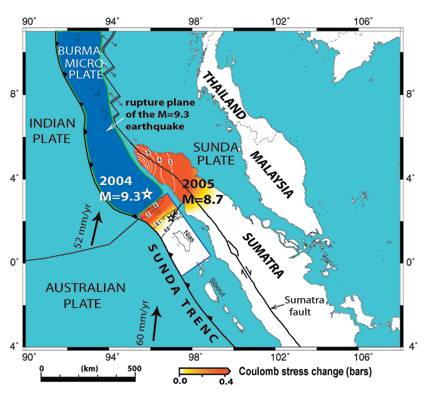| 2005 |

|
YEAR BOOK |
University of Ulster
|
Earthquake hazard in Sumatra
|
Research by the Geophysics Research Group on the rapid computation of stress changes following large earthquakes is improving our ability to make short-term estimations of seismic hazard. Recent world-wide research has demonstrated that very small stress changes can greatly influence the location of subsequent events; regions that experience positive stress changes of as little as 0.1 bar become much more likely to have earthquakes while a temporary cessation of seismic activity is often observed in areas experiencing stress decreases of a similar magnitude.
On St. Stephen's Day, 2004, a great earthquake occurred in the Indian Ocean. At magnitude 9.3, this earthquake was the second largest ever recorded; the tsunami generated by it had tragic consequences for Indonesia, Thailand, Sri Lanka, India, and other countries in the region. Following this earthquake, we calculated the stress change on nearby faults and found that both the Sumatra fault and the Sunda Trench (see figure) had experienced large stress increases, up to 8 bars. Both of these structures are capable of producing large earthquakes; the Sumatra Fault as large as about M=7.5, the Sunda trench as large as M=9. This work was published in Nature on 17 March 2005.

More information about the Geophysics Research Group and its work on earthquake physics, fluid flow in fractured porous media, and aeolian sediment transport can be found at http://www.science.ulster.ac.uk/geophys/ or by emailing Dr. Sandy Steacy at [email protected]